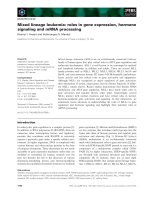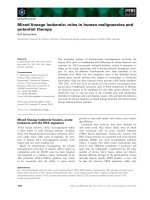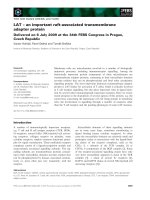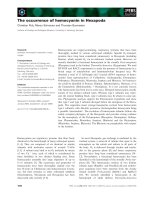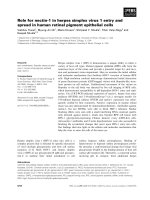Tài liệu Báo cáo khoa học: "Hidden Markov Tree Model in Dependency-based Machine Translation∗" pptx
Bạn đang xem bản rút gọn của tài liệu. Xem và tải ngay bản đầy đủ của tài liệu tại đây (169.99 KB, 4 trang )
Proceedings of the ACL-IJCNLP 2009 Conference Short Papers, pages 145–148,
Suntec, Singapore, 4 August 2009.
c
2009 ACL and AFNLP
Hidden Markov Tree Model in Dependency-based Machine Translation
∗
Zden
ˇ
ek
ˇ
Zabokrtsk
´
y
Charles University in Prague
Institute of Formal and Applied Linguistics
Martin Popel
Charles University in Prague
Institute of Formal and Applied Linguistics
Abstract
We would like to draw attention to Hid-
den Markov Tree Models (HMTM), which
are to our knowledge still unexploited in
the field of Computational Linguistics, in
spite of highly successful Hidden Markov
(Chain) Models. In dependency trees,
the independence assumptions made by
HMTM correspond to the intuition of lin-
guistic dependency. Therefore we suggest
to use HMTM and tree-modified Viterbi
algorithm for tasks interpretable as label-
ing nodes of dependency trees. In par-
ticular, we show that the transfer phase
in a Machine Translation system based
on tectogrammatical dependency trees can
be seen as a task suitable for HMTM.
When using the HMTM approach for
the English-Czech translation, we reach a
moderate improvement over the baseline.
1 Introduction
Hidden Markov Tree Models (HMTM) were intro-
duced in (Crouse et al., 1998) and used in appli-
cations such as image segmentation, signal classi-
fication, denoising, and image document catego-
rization, see (Durand et al., 2004) for references.
Although Hidden Markov Models belong to the
most successful techniques in Computational Lin-
guistics (CL), the HMTM modification remains to
the best of our knowledge unknown in the field.
The first novel claim made in this paper is that
the independence assumptions made by Markov
Tree Models can be useful for modeling syntactic
trees. Especially, they fit dependency trees well,
because these models assume conditional depen-
dence (in the probabilistic sense) only along tree
∗
The work on this project was supported by the grants
MSM 0021620838, GAAV
ˇ
CR 1ET101120503, and M
ˇ
SMT
ˇ
CR LC536. We thank Jan Haji
ˇ
c and three anonymous review-
ers for many useful comments.
edges, which corresponds to intuition behind de-
pendency relations (in the linguistic sense) in de-
pendency trees. Moreover, analogously to applica-
tions of HMM on sequence labeling, HMTM can
be used for labeling nodes of a dependency tree,
interpreted as revealing the hidden states
1
in the
tree nodes, given another (observable) labeling of
the nodes of the same tree.
The second novel claim is that HMTMs are
suitable for modeling the transfer phase in Ma-
chine Translation systems based on deep-syntactic
dependency trees. Emission probabilities rep-
resent the translation model, whereas transition
(edge) probabilities represent the target-language
tree model. This decomposition can be seen as
a tree-shaped analogy to the popular n-gram ap-
proaches to Statistical Machine Translation (e.g.
(Koehn et al., 2003)), in which translation and lan-
guage models are trainable separately too. More-
over, given the input dependency tree and HMTM
parameters, there is a computationally efficient
HMTM-modified Viterbi algorithm for finding the
globally optimal target dependency tree.
It should be noted that when using HMTM, the
source-language and target-language trees are re-
quired to be isomorphic. Obviously, this is an un-
realistic assumption in real translation. However,
we argue that tectogrammatical deep-syntactic de-
pendency trees (as introduced in the Functional
Generative Description framework, (Sgall, 1967))
are relatively close to this requirement, which
makes the HMTM approach practically testable.
As for the related work, one can found a num-
ber of experiments with dependency-based MT
in the literature, e.g., (Boguslavsky et al., 2004),
(Menezes and Richardson, 2001), (Bojar, 2008).
However, to our knowledge none of the published
systems searches for the optimal target representa-
1
HMTM looses the HMM’s time and finite automaton in-
terpretability, as the observations are not organized linearly.
However, the terms “state” and “transition” are still used.
145
6285&(/$1*8$*(775(( 7$5*(7/$1*8$*(775((
;Y
WUDQVLWLRQSUREV
3;X_;Y
IURPWUHHPRGHO
RSWLPDOVWDWHWUHH
UHYHDOHGE\WUHH9LWHUEL
KLGGHQVWDWHV
QRGHWUDQVODWLRQ
K\SRWKHVHV
<X
;X
HPLVVLRQSUREV
3<X_;X
IURPEDFNZDUG
WUDQVODWLRQPRGHO
IURPWUHHPRGHO
75$16)(5
Figure 1: Tectogrammatical transfer as a task for HMTM.
tion in a way similar to HMTM.
2 Hidden Markov Tree Models
HMTM are described very briefly in this section.
More detailed information can be found in (Du-
rand et al., 2004) and in (Diligenti et al., 2003).
Suppose that V = {v
1
, . . . , v
|V |
} is the set of
tree nodes, r is the root node and ρ is a function
from V \r to V storing the parent node of each
non-root node. Suppose two sequences of ran-
dom variables, X = (X(v
1
), . . . , X(v
|V |
)) and
Y = (Y (v
1
), . . . , Y (v
|V |
)), which label all nodes
from V . Let X(v) be understood as a hidden state
of the node v, taking a value from a finite state
space S = {s
1
, . . . , s
K
}. Let Y (v) be understood
as a symbol observable on the node v, taking
a value from an alphabet K = {k
1
, . . . , k
2
}.
Analogously to (first-order) HMMs, (first-order)
HMTMs make two independence assumptions:
(1) given X(ρ(v)), X(v) is conditionally inde-
pendent of any other nodes, and (2) given X(v),
Y (v) is conditionally independent of any other
nodes. Given these independence assumptions,
the following factorization formula holds:
2
P (Y , X) = P (Y (r)|X(r))P (X(r)) ·
v∈V \r
P (Y (v)|X(v))P (X(v)|X(ρ(v))) (1)
We see that HMTM (analogously to HMM,
again) is defined by the following parameters:
2
In this work we limit ourselves to fully stationary
HMTMs. This means that the transition and emission prob-
abilities are independent of v. This “node invariance” is an
analogy to HMM’s time invariance.
• P (X(v)|X(ρ(v))) – transition probabilities
between the hidden states of two tree-
adjacent nodes,
3
• P (Y (v)|X(v)) – emission probabilities.
Naturally the question appears how to restore
the most probable hidden tree labeling given the
observed tree labeling (and given the tree topol-
ogy, of course). As shown in (Durand et al., 2004),
a modification of the HMM Viterbi algorithm can
be found for HMTM. Briefly, the algorithm starts
at leaf nodes and continues upwards, storing in
each node for each state and each its child the op-
timal downward pointer to the child’s hidden state.
When the root is reached, the optimal state tree is
retrieved by downward recursion along the point-
ers from the optimal root state.
3 Tree Transfer as a Task for HMTM
HMTM Assumptions from the MT Viewpoint.
We suggest to use HMTM in the conventional
tree-based analysis-transfer-synthesis translation
scheme: (1) First we analyze an input sentence to
a certain level of abstraction on which the sentence
representation is tree-shaped. (2) Then we use
HMTM-modified Viterbi algorithm for creating
the target-language tree from the source-language
tree. Labels on the source-language nodes are
treated as emitted (observable) symbols, while la-
bels on the target-language nodes are understood
as hidden states which are being searched for
3
The need for parametrizing also P (X(r)) (prior proba-
bilites of hidden states in the root node) can be avoided by
adding an artificial root whose state is fixed.
146
(Figure 1). (3) Finally, we synthesize the target-
language sentence from the target-language tree.
In the HMTM transfer step, the HMTM emis-
sion probabilities can be interpreted as probabil-
ities from the “backward” (source given target)
node-to-node translation model. HMTM transi-
tion probabilities can be interpreted as probabil-
ities from the target-language tree model. This is
an important feature from the MT viewpoint, since
the decomposition into translation model and lan-
guage model proved to be extremely useful in sta-
tistical MT since (Brown et al., 1993). It allows
to compensate the lack of parallel resources by the
relative abundance of monolingual resources.
Another advantage of the HMTM approach is
that it allows us to disregard the ordering of de-
cisions made with the individual nodes (which
would be otherwise nontrivial, as for a given node
there might be constraints and preferences coming
both from its parent and from its children). Like in
HMM, it is the notion of hidden states that facil-
itates “summarizing” distributed information and
finding the global optimum.
On the other hand, there are several limitations
implied by HMTMs which we have to consider be-
fore applying it to MT: (1) There can be only one
labeling function on the source-language nodes,
and one labeling function on the target-language
nodes. (2) The set of hidden states and the al-
phabet of emitted symbols must be finite. (3) The
source-language tree and the target-language tree
are required to be isomorphic. In other words, only
node labeling can be changed in the transfer step.
The first two assumption are easy to fulfill, but
the third assumption concerning the tree isomor-
phism is problematic. There is no known linguistic
theory guaranteeing identically shaped tree repre-
sentations of a sentence and its translation. How-
ever, we would like to show in the following that
the tectogrammatical layer of language description
is close enough to this ideal to make the HMTM
approach practically applicable.
Why Tectogrammatical Trees? Tectogram-
matical layer of language description was
introduced within the Functional Generative
Description framework, (Sgall, 1967) and has
been further elaborated in the Prague Dependency
Treebank project, (Haji
ˇ
c and others, 2006).
On the tectogrammatical layer, each sentence is
represented as a tectogrammatical tree (t-tree for
short; abbreviations t-node and t-layer are used in
the further text too). The main features of t-trees
(from the viewpoint of our experiments) are fol-
lowing. Each sentence is represented as a depen-
dency tree, whose nodes correspond to autoseman-
tic (meaningful) words and whose edges corre-
spond to syntactic-semantic relations (dependen-
cies). The nodes are labeled with the lemmas of
the autosemantic words. Functional words (such
as prepositions, auxiliary verbs, and subordinat-
ing conjunctions) do not have nodes of their own.
Information conveyed by word inflection or func-
tional words in the surface sentence shape is repre-
sented by specialized semantic attributes attached
to t-nodes (such as number or tense).
T-trees are still language specific (e.g. be-
cause of lemmas), but they largely abstract from
language-specific means of expressing non-lexical
meanings (such as inflection, agglutination, func-
tional words). Next reason for using t-trees as the
transfer medium is that they allow for a natural
transfer factorization. One can separate the trans-
fer into three relatively independent channels:
4
(1)
transfer of lexicalization (stored in t-node’s lemma
attribute), (2) transfer of syntactizations (stored
in t-node’s formeme attribute),
5
and (3) transfer
of semantically indispensable grammatical cate-
gories
6
such as number with nouns and tense with
verbs (stored in specialized t-node’s attributes).
Another motivation for using t-trees is that
we believe that local tree contexts in t-trees
carry more information relevant for correct lexical
choice, compared to linear contexts in the surface
sentence shapes, mainly because of long-distance
dependencies and coordination structures.
Observed Symbols, Hidden States, and HMTM
Parameters. The most difficult part of the
tectogrammatical transfer step lies in transfer-
4
Full independence assumption about the three channels
would be inadequate, but it can be at least used for smoothing
the translation probabilities.
5
Under the term syntactization (the second channel) we
understand morphosyntactic form – how the given lemma is
“shaped” on the surface. We use the t-node attribute formeme
(which is not a genuine element of the semantically ori-
ented t-layer, but rather only a technical means that facili-
tates modeling the transition between t-trees and surface sen-
tence shapes) to capture syntactization of the given t-node,
with values such as n:subj – semantic noun (s.n.) in sub-
ject position, n:for+X – s.n. with preposition for, n:poss –
possessive form of s.n., v:because+fin – semantic verb as a
subordinating finite clause introduced by because), adj:attr –
semantic adjective in attributive position.
6
Categories only imposed by grammatical constraints
(e.g. grammatical number with verbs imposed by subject-
verb agreement in Czech) are disregarded on the t-layer.
147
ring lexicalization and syntactization (attributes
lemma and formeme), while the other attributes
(node ordering, grammatical number, gender,
tense, person, negation, degree of comparison
etc.) can be transferred by much less complex
methods. As there can be only one input labeling
function, we treat the following ordered pair as
the observed symbol: Y (v) = (L
src
(v), F
src
(v))
where L
src
(v) is the source-language lemma of
the node v and F
src
(v) is its source-language
formeme. Analogously, hidden state of node v is
the ordered couple X(v) = (L
trg
(v), F
trg
(v)),
where L
trg
(v) is the target-language lemma of
the node v and F
trg
(v) is its target-language
formeme. Parameters of such HMTM are then
following:
P (X(v)|X(ρ(v))) = P (L
trg
(v), F
trg
(v)|L
trg
(ρ(v)), F
trg
(ρ(v)))
– probability of a node labeling given its parent
labeling; it can be estimated from a parsed
target-language monolingual corpus, and
P (Y (v)|X(v)) = P (L
src
(v), F
src
(v)|L
trg
(v), F
trg
(v))
– backward translation probability; it can be esti-
mated from a parsed and aligned parallel corpus.
To summarize: the task of tectogrammatical
transfer can be formulated as revealing the values
of node labeling functions L
trg
and F
trg
given the
tree topology and given the values of node label-
ing functions L
src
and F
src
. Given the HMTM
parameters specified above, the task can be solved
using HMTM-modified Viterbi algorithm by inter-
preting the first pair as the hidden state and the
second pair as the observation.
4 Experiment
To check the real applicability of HMTM transfer,
we performed the following preliminary MT ex-
periment. First, we used the tectogrammar-based
MT system described in (
ˇ
Zabokrtsk
´
y et al., 2008)
as a baseline.
7
Then we substituted its transfer
phase by the HMTM variant, with parameters esti-
mated from 800 million word Czech corpus and 60
million word parallel corpus. As shown in Table 1,
the HMTM approach outperforms the baseline so-
lution both in terms of BLEU and NIST metrics.
5 Conclusion
HMTM is a new approach in the field of CL. In our
opinion, it has a big potential for modeling syntac-
7
For evaluation purposes we used 2700 sentences from
the evaluation section of WMT 2009 Shared Translation
Task. />System BLEU NIST
baseline system 0.0898 4.5672
HMTM modification 0.1043 4.8445
Table 1: Evaluation of English-Czech translation.
tic trees. To show how it can be used, we applied
HMTM in an experiment on English-Czech tree-
based Machine Translation and reached an im-
provement over the solution without HMTM.
References
Igor Boguslavsky, Leonid Iomdin, and Victor Sizov.
2004. Multilinguality in ETAP-3: Reuse of Lexi-
cal Resources. In Proceedings of Workshop Multi-
lingual Linguistic Resources, COLING, pages 7–14.
Ond
ˇ
rej Bojar. 2008. Exploiting Linguistic Data in Ma-
chine Translation. Ph.D. thesis,
´
UFAL, MFF UK,
Prague, Czech Republic.
Peter E. Brown, Vincent J. Della Pietra, Stephen A.
Della Pietra, and Robert L. Mercer. 1993. The
mathematics of statistical machine translation: Pa-
rameter estimation. Computational Linguistics.
Matthew Crouse, Robert Nowak, and Richard Bara-
niuk. 1998. Wavelet-based statistical signal pro-
cessing using hidden markov models. IEEE Trans-
actions on Signal Processing, 46(4):886–902.
Michelangelo Diligenti, Paolo Frasconi, and Marco
Gori. 2003. Hidden tree Markov models for doc-
ument image classification. IEEE Transactions on
Pattern Analysis and Machine Intelligence, 25:2003.
Jean-Baptiste Durand, Paulo Goncalv
`
es, and Yann
Gu
´
edon. 2004. Computational methods for hid-
den Markov tree models - An application to wavelet
trees. IEEE Transactions on Signal Processing,
52(9):2551–2560.
Jan Haji
ˇ
c et al. 2006. Prague Dependency Treebank
2.0. Linguistic Data Consortium, LDC Catalog No.:
LDC2006T01, Philadelphia.
Philipp Koehn, Franz Josef Och, and Daniel Marcu.
2003. Statistical phrase based translation. In Pro-
ceedings of the HLT/NAACL.
Arul Menezes and Stephen D. Richardson. 2001. A
best-first alignment algorithm for automatic extrac-
tion of transfer mappings from bilingual corpora. In
Proceedings of the workshop on Data-driven meth-
ods in machine translation, volume 14, pages 1–8.
Petr Sgall. 1967. Generativn
´
ı popis jazyka a
ˇ
cesk
´
a
deklinace. Academia, Prague, Czech Republic.
Zden
ˇ
ek
ˇ
Zabokrtsk
´
y, Jan Pt
´
a
ˇ
cek, and Petr Pajas. 2008.
TectoMT: Highly Modular MT System with Tec-
togrammatics Used as Transfer Layer. In Proceed-
ings of the 3rd Workshop on SMT, ACL.
148





